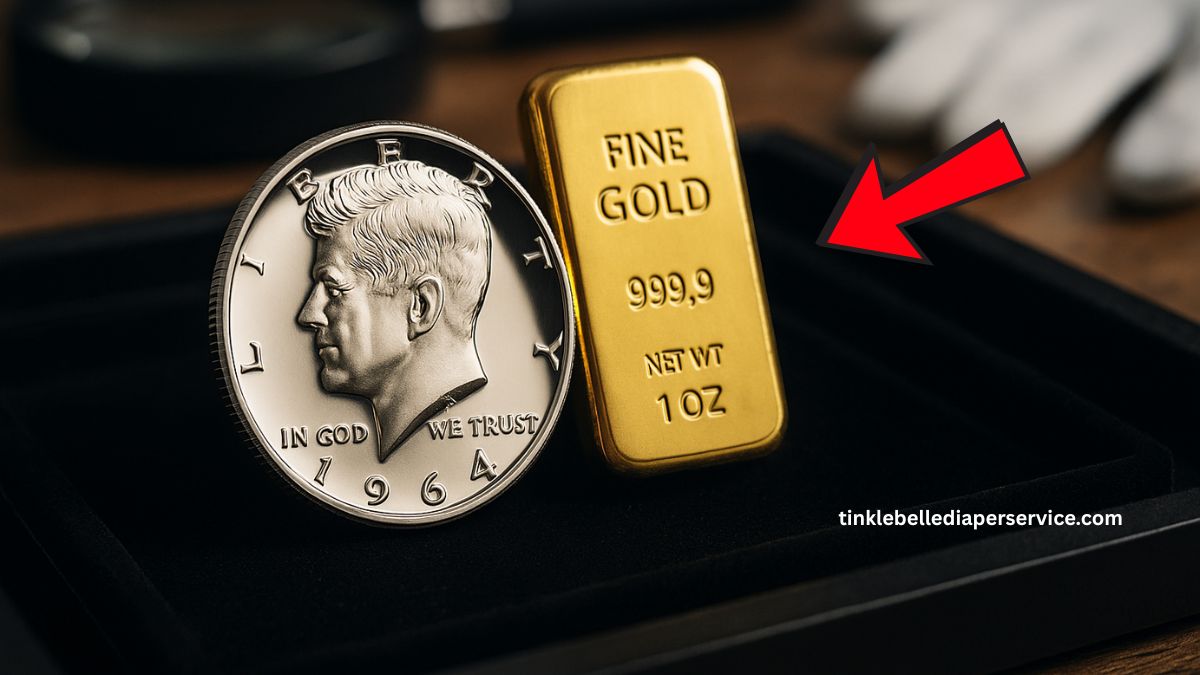When most people think of wealth, gold bars often come to mind. But in a surprising turn within the world of rare coin collecting, a 1964 Kennedy Half Dollar has outshined a 1-ounce gold bar in value—selling for over $2,800, with some ultra-rare specimens crossing the $10,000 mark and even nearing $50,000.
This astonishing outcome underscores how numismatic value can trump even the worth of pure precious metals.
The History Behind the 1964 Kennedy Half Dollar
The Kennedy Half Dollar was first issued in 1964, just months after the tragic assassination of President John F. Kennedy. As a tribute to the fallen president, the U.S. Mint worked quickly to introduce the coin.
The 1964 issue was made from 90% silver, making it the only year the coin was struck with such high silver content for general circulation. Later versions switched to a copper-nickel composition due to rising silver costs.
This coin carries emotional and historical significance—a snapshot of national grief and unity that elevated its desirability from day one.
What Makes the “Accented Hair” Variety So Special?
While millions of 1964 Kennedy Half Dollars were minted, a limited number of proof coins struck at the Philadelphia Mint featured a design now known as the “Accented Hair” variety.
These coins display sharper, more detailed hair strands above Kennedy’s ear—a feature that was later softened at the request of the Kennedy family.
Additional identifiers include:
- A missing serif on the “I” in LIBERTY
- A frosted portrait contrasting with a mirrored field (in Deep Cameo versions)
Only an estimated 50,000 to 100,000 of these proof coins were minted, making them scarce—especially in high grades.
Grading and Auction Value: Proof-68 DCAM and Beyond
Grading plays a crucial role in a coin’s value. The Professional Coin Grading Service (PCGS) and Numismatic Guaranty Corporation (NGC) assign grades based on strike quality, luster, preservation, and eye appeal.
A 1964 Accented Hair Kennedy Half Dollar graded PR68DCAM (Deep Cameo) can command prices from $2,500 to $3,000, depending on auction conditions.
Even more impressive, a PR69DCAM version—near perfect—has sold for over $46,000, and rare specimens have reportedly crossed $70,000.
Coin vs. Gold: A Surprising Value Comparison
Here’s how the 1964 Kennedy Half Dollar measures up to a 1-ounce gold bar:
| Feature | 1964 Kennedy Half Dollar (Accented Hair, PR68DCAM) | 1-Ounce Gold Bar |
|---|---|---|
| Face Value | $0.50 | None |
| Material Composition | 90% Silver | 99.99% Pure Gold |
| Weight | 12.5 grams | 31.1 grams |
| Auction Value (Recent) | $2,800+ | $2,300–$2,500 (May 2025) |
| Historical Significance | High (Post-assassination tribute) | Low |
| Design Variety Scarcity | High | N/A |
| Collector Demand | High | Moderate (investment-based) |
| Emotional/Patriotic Appeal | Extremely High | None |
Despite weighing less and containing no gold, the Kennedy Half Dollar’s historic importance, low mintage, and flawless grading pushed its market price higher than gold.
Why Numismatic Value Can Outpace Metal Worth
Unlike bullion which is valued purely by weight and spot prices, rare coins derive value from multiple layers:
- Rarity (low mintage or unique variations)
- Condition (mint-state or proof with cameo effects)
- Historical Relevance (JFK’s assassination)
- Collector Demand (active markets and bidding wars)
These factors can create enormous value for a single coin—sometimes well beyond its material content.
Collector Tips: Could You Have One Too?
Search Your Collection
If you or your family has old U.S. coins, especially from 1964, check for:
- Proof coins from sets
- Hair detailing above JFK’s ear
- Uncirculated or near-mint condition
Get It Graded
Professional grading by PCGS or NGC not only authenticates your coin but can multiply its resale value. Even if you’re not planning to sell, knowing your coin’s grade ensures it’s properly insured and stored.
Store It Properly
Coins can rapidly lose value if damaged. Here’s how to preserve them:
- Use acid-free holders, plastic capsules, or slabbed containers
- Handle only with cotton gloves
- Store in a cool, dry place with stable humidity
What This Means for Investors and Hobbyists
This isn’t just a story for hardcore numismatists. The soaring value of the 1964 Kennedy Half Dollar proves that significant financial opportunities exist in everyday objects—especially those passed down across generations.
Many Americans possess old coin collections without realizing the value hidden within. With the right knowledge and a bit of luck, you might be sitting on a five-figure coin that started as simple change.
The 1964 Accented Hair Kennedy Half Dollar is more than a tribute to a beloved president—it’s a stunning example of how history, rarity, and condition can turn pocket change into a $10,000+ treasure.
In a time when gold is seen as the ultimate store of value, this coin reminds us that stories, craftsmanship, and legacy can be even more powerful.
Whether you’re a seasoned collector or new to the hobby, now might be the perfect time to check your coin jar—you never know what piece of history you might be holding.
FAQs
How do I know if my Kennedy Half Dollar is the “Accented Hair” variety?
Look for enhanced hair detail above JFK’s ear and a missing serif on the “I” in LIBERTY. These features are exclusive to the early proof sets minted in 1964.
Why are some Kennedy Half Dollars worth thousands while others are not?
Most Kennedy Half Dollars are worth face value or their silver content. Only specific versions, like the 1964 Accented Hair Proof coins in high grades, achieve premium value due to rarity and collector demand.
Is investing in rare coins better than gold?
It depends on your goals. Coins can offer higher returns, but they require more knowledge and market understanding. Gold is more stable and liquid but doesn’t offer the same potential for exponential growth as rare collectibles.

